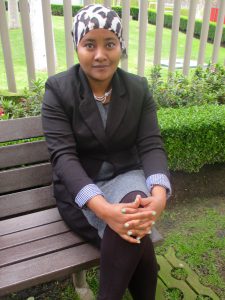CANADIAN IMMIGRANTS ADJUST TO LIFE IN THEIR NEW COUNTRY.
Meghan Gauvin
In 2001, when Dammee Sero was nine, she and her family were forced to flee their home in Ethiopia. They were members of the Oromo people, the largest ethnic group in the country, which had become the target of political persecution. They fled to Nairobi and later settled in a refugee camp in Kenya. Sero says she lived in fear the entire time she was there. Gender violence was a serious concern, and people were often attacked while walking alone at night. Although she never experienced this violence first hand, there was a constant, lingering fear for her own safety as well as for the safety of her family. After 10 years of living in the camp, Sero was offered admission to Wilfrid Laurier University in Brantford, Ont., through the World University Service of Canada. Although she was nervous and sad to leave her family, Sero was also excited to take advantage of this opportunity that she would never have in Kenya.

When she arrived in Brantford, she found an entirely different world from the one she had left. “I was so happy to come to Canada,” she says. “But there is a stage where everything is new and a little homesick.” All of her family and friends were back home, and nothing from this new culture reminded her of her own. Troubled and lonely, Sero pressed on.
Moving away from the only home you have ever known is a journey filled with challenges. For the more than one million people immigrating to Canada since 2011, there are many challenges to be faced even after having entered the country. One of the most harrowing of these challenges is the social isolation experienced by many newcomers.
Between 2011 and 2016, 1.2 million people immigrated here, according to Immigration, Refugees and Citizenship Canada, taking immigration rates to an all-time high. About one in five people in Canada today is an immigrant. Ontario is the most popular place to settle, hosting 39 per cent of all immigrants. This is largely due to chain migration, as groups of people from one area follow others to the same destination. In other words, people tend to migrate to an area if there are people or cultures already there that they are familiar with. Having those social supports in place is one of the main ways newcomers can combat feelings of isolation.
Language barriers have a significant impact on how well an immigrant will be able to integrate into Canadian society. According to 2016 census data, 72.5 per cent of immigrants reported having a mother tongue other than English or French. When 10-year-old Teeba Alsafar arrived in Canada, she spoke only Arabic, which her Iraqi parents spoke at home. Her parents had fled the country in the late ’70s, as Saddam Hussein came to power. They then lived in various countries, including Yemen, Syria and Czech Republic, before settling in Canada as refugees in 1990. Not being able to communicate with her classmates made things hard at school for Alsafar. “I wasn’t part of this big, huge group. I was an isolated situation.” Ironically, the isolation led her to integrate quickly, she says. “I was a newcomer. I had no choice.” Due to the dedication of her ESL teacher, she was able to join in with her regular classes without extra assistance after about eight months.

For some people, overcoming social isolation also means facing racism. For example, according to a 2016 poll conducted by Research House, 30 per cent of respondents strongly agreed that immigrants were taking jobs from Canadians while 65 per cent also stated they were proud of Canada’s multiculturalism. That disconnect may come down to ignorance of other cultures, as Jamaal Owusu-Ansah learned. Although he was born in Canada, he moved back to his families’ home in Ghana when he was six. He stayed there for 10 years before returning to Toronto in Grade 10 to finish his education.
Owusu-Ansah says it was difficult to adjust to being around people who knew nothing about his home country. During his first few months back in Canada, he experienced a lot of ignorance from his classmates. Once, a classmate asked him if he lived in a hut while he was in Ghana. Other stereotypes followed him as well. “People just think that because you’re of this race or this complexion then you can only have [one] ability, which the majority of the time is more related to sports than it is to intelligence,” he says. One way Owusu-Ansah was able to endure the racism and ignorance he encountered was through the support system of his family. In fact, he attributes his successful integration to the emotional support of his cousins who took him under their wing. He says he’s not sure how other newcomers are able to integrate without family there to help them.
Another factor that contributes to the isolation of newcomers is culture shock. When Sero arrived in Brantford from the Kenyan refugee camp where she’d lived for 10 years, she was away from her family for the first time and alone in a new country. No one spoke her native language, cooked her favourite food or understood the political struggles of her home country. Everything was different and in some ways frightening. Luckily, she found a group of Oromo in the Hamilton area. With the support of the group, Sero was able to stay connected to her community and her culture, which made for an easier transition into Canadian society. “Having someone who speaks the same language and cooks the same food makes it feel like home.”
Today, Sero has graduated university and lives in Dartmouth, N.S., working as an intern at Service Canada. She sees Canada as her new home and has plans to bring her family over so they can be reunited. “There were highs and then there were lows—the lowest—but then you make friends,” says Dammee. “I ended up absolutely loving it here.”
